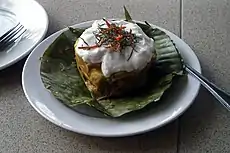Ho mok
In South-East Asian cuisine, ho mok (alternatively, homok, or hor mok) refers to the process of steam cooking a curry in banana leaves, or to the resulting dish. Thick coconut cream and galangal are classic ingredients, added to a wide range of possible kinds of leaves and staple ingredients.
 Ho mok pla (fish ho mok) in Thailand | |
| Type | Curry |
|---|---|
| Place of origin | Thailand[1][2] |
| Main ingredients | Curry, banana leaves |

Preparing Thai ho mok pla for steaming

Amok trey – Cambodian fish amok
The base dish or process is locally referred to as:
A wide variety of ingredients can be used to prepare ho mok dishes. The main ingredient will usually give its name to the dish:
- fish – ห่อหมกปลา [hɔ̀ː.mòk plāː] in Thai; ຫມົກປາ [mók paː] in Lao; ហហ្មុកត្រី [haː.mok trəj] in Khmer
- bamboo shoots – ห่อหมกหน่อไม้ [hɔ̀ː.mòk nɔ̀ː máːj] in Thai; ຫມົກຫນໍ່ໄມ້ [mók nɔ̄ː mâj] in Lao (often with minced meat inside)
- chicken – ห่อหมกไก่ [hɔ̀ː.mòk kàj] in Thai
- tofu – ห่อหมกเต้าหู้ [hɔ̀ː.mòk tâw.hûː] in Thai
- eggs – ຫມົກໄຂ່ [mók kʰāj] in Lao (often with minced meat inside)
- algae – as in the Laotian ຫມົກໄຄ [mók kʰáj] (with Mekong weed)
See also
References
| Wikimedia Commons has media related to ho mok. |
- "BangkokFoodie Guide: Everything You Need To Know".
- "Hor Mok (ห่อหมก) – Thai Curried Fish Custard and The Principles of Thai Cookery by Chef McDang". She Simmers. Retrieved 4 October 2019.
This article is issued from Wikipedia. The text is licensed under Creative Commons - Attribution - Sharealike. Additional terms may apply for the media files.